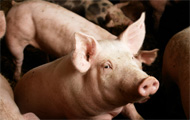Decline in antibiotic use for Dutch livestock

The use of antibiotics on farm animals in the Netherlands decreased in 2008 for the first time after several years of increasing use.
An international comparison shows that in most European countries studied, sales of antibiotics in 2008 were at about the same level as in 2007; but in Norway, France, and the Netherlands, sales of antibiotics were down by more than 5 per cent in the same period. These results were published in the annual MARAN report (early April).
©
Survey figures on use of antibiotics in specific animal species in the Netherlands are more varied. These figures show a tendency towards increased use on fattening pigs, broilers, and dairy cattle, but at the same time show a drop in use on sows, piglets, and veal calves.
©
The levels of antimicrobial resistance in bacteria from the most important food-producing animals in the Netherlands (cattle, pigs, and broilers) changed very little in 2008. However, there was an increase in ciprofloxacin resistance in both E. coli from the intestines of broilers and Campylobacter from both broilers and humans. As in previous years, the highest levels of resistance were observed in broilers. This indicates that broilers offer optimum conditions for the selection and distribution of resistant bacteria.
©
©











